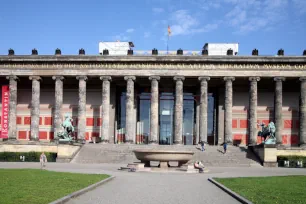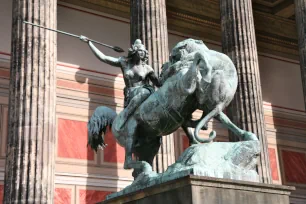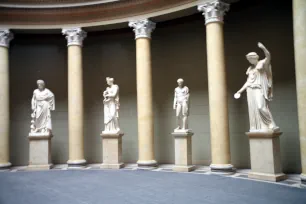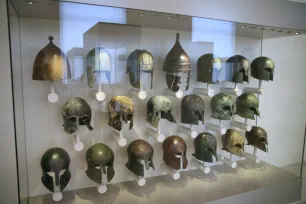One of the masterpieces of the area known as Museum Island, the Altes Museum (Old Museum) was the first dedicated museum building in Berlin. The museum is home to a collection of Classical Antiquities.
Founding of the Museum

In the early nineteenth century, King Frederick William III forged plans for a public museum in Berlin. When many of Germany’s treasures were recovered from France after Napoleon’s defeat in 1815, his plans received the support of the public and soon designs were drawn up for a royal museum to house all the artwork.
A plot just north of a beautiful pleasure garden, created in the seventeenth century by princess Louise, was selected as the location for what would become the first museum in the city.
Construction and reconstruction

The design for the museum was devised by Berlin’s great architect Karl Friedrich Schinkel. Built between 1825 and 1830 as the Royal Museum, it initially housed the royal art collection. The museum was situated across the garden from the Royal Palace, which was demolished after the Second World War.
The museum, which adopted its current name “Altes Museum” (Old Museum) in 1845, was severely damaged during the war and in 1945 was almost completely destroyed when a tank truck that was parked in front of the building exploded. After the war, the Altes Museum was the first of the group museums on Museum Island to be renovated, and it reopened in 1966.
Architecture

The Altes Museum is considered one of Berlin’s most impressive neoclassical buildings. Eighteen Ionic columns grace the front of this grand museum. The rectangular shaped building encloses two generous courtyards and a two-story centrally-located rotunda, based on the design of the Pantheon in Rome. The interior of the rotunda contains sculptures of gods of antiquity in the recesses of its walls. Two statues flank the wide outdoor steps. Entitled Amazon and Lion Fighter, they were designed by August Kiss and Albert Wolff.
The Museum Collection
Today, the Altes Museum houses the Antikensammlung (Museum of Antiquities) on its main floor. The permanent collection here includes a vast variety of ancient Greek and Roman decorative art, including vases and statues. These are mostly smaller objects, since the large monuments from the Antiquity are on display in the nearby Pergamon Museum.

The ground floor is dedicated to the museum’s famed Greek collection and includes highlights such as the ‘Praying Boy’, a bronze sculpture from Rhodes from around 300 BC. The museum also boasts one of the world’s finest collections of Greek vases, including an amphora by the so-called ‘Berlin painter’ and a bowl from 515 BC painted by the Athenian artist Euphronios.
The museum is also home to a numismatic collection from the Münzkabinett, which shows more than one thousand coins from the seventh century BC up to the third century AD. The main collection of the Münzkabinett is housed in the Bode Museum, also on Museum Island.
On the upper floor you’ll find the Etruscan and Roman collections. The Etruscan collection is one of the largest outside Italy. Here you can see objects dating back to the eight century BC. Highlights include house-shaped limestone urns from Chiusi and a clay tablet from Capua. There are numerous Roman statues and busts of Roman emperors. And there’s even an ‘erotic cabinet’, a collection with sexually explicit paintings, reliefs and sculptures from the Antiquity. This collection is behind a closed door and only recommended for visitors of 18 years and older.
- Next: Kurfürstendamm
- More Sights & Attractions in Berlin

